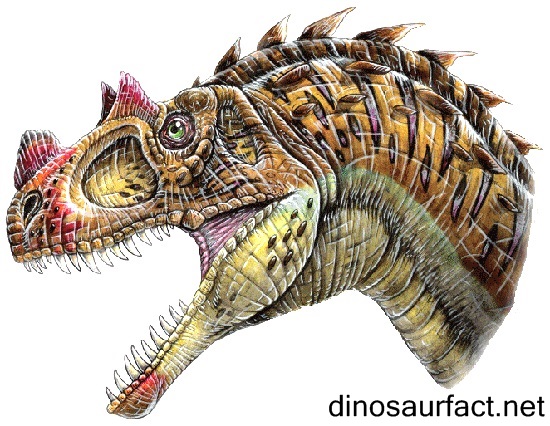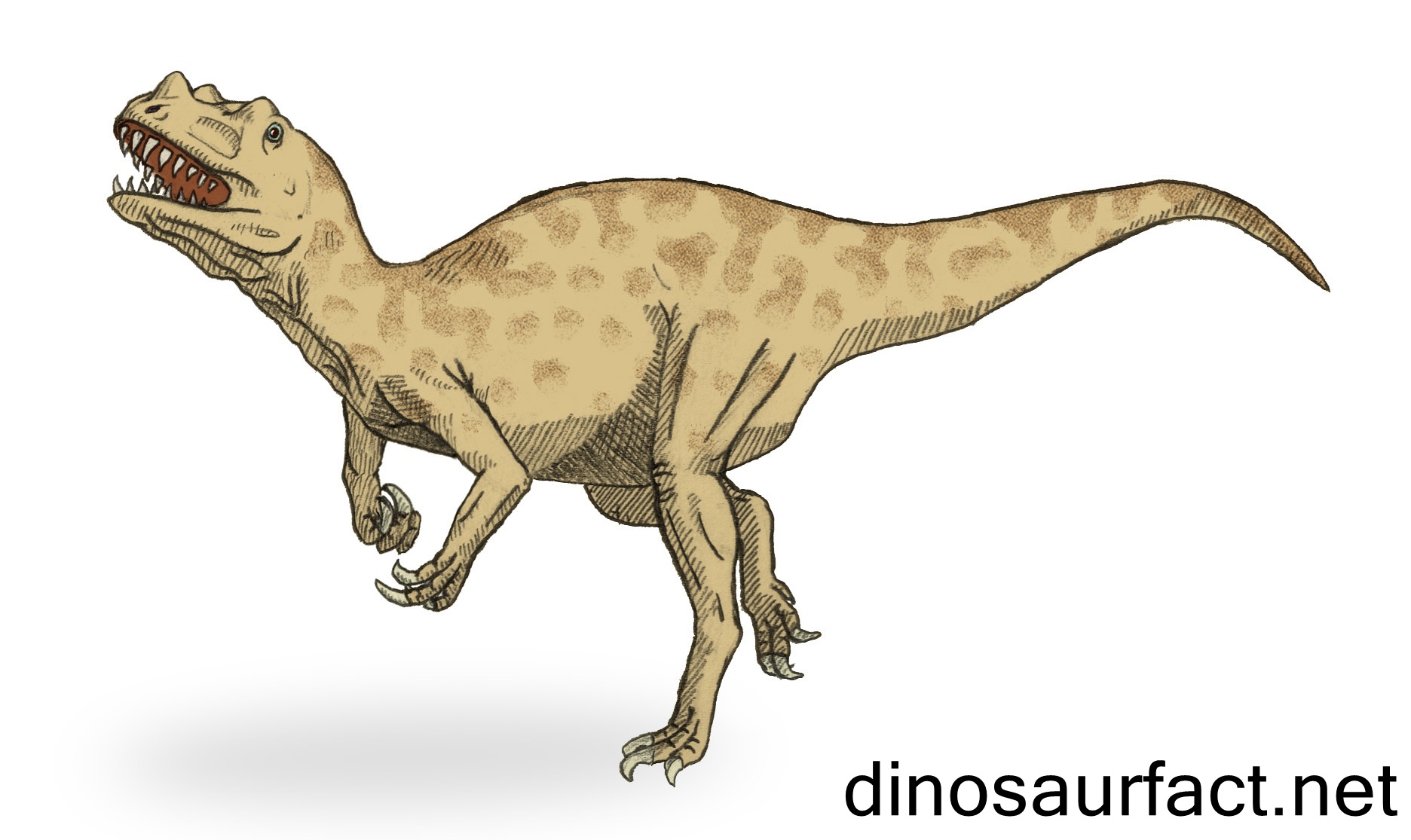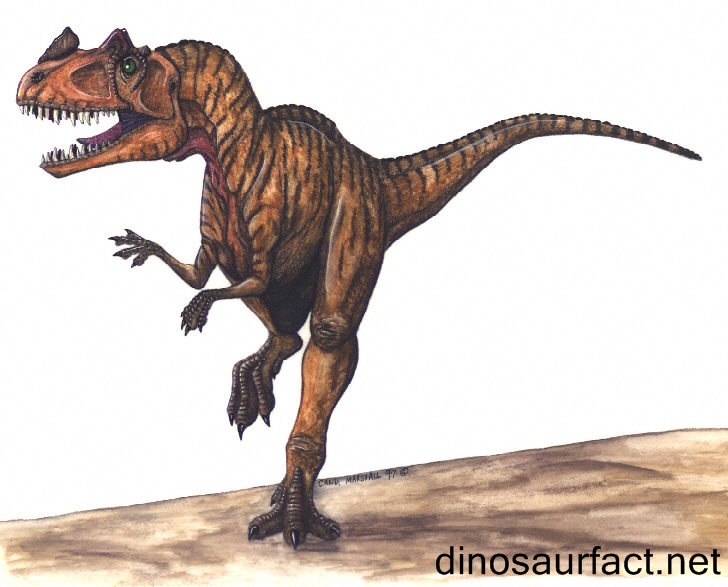 Click to visit the previous dinosaur bio
Click to visit the previous dinosaur bio
 |
|
 |
|
Kingdom: Animalia
Phylum: Chordata
Class: Sauropsida
SuperOrder: Dinosauria
Order: Theropoda
Family: Ceratosauridae
Genus: Ceratosaurus
 |
|
 |
|
 |
|

The Ceratosaurus was a relatively small theropod dinosaur. It was carnivorous and bipedal. It was in existence in the latter part of the Jurassic period. This was the border of the Kimmeridgian and Tithonian ages. The approximate time of its presence on the earth was 155 t0 145 million years ago.
The length of the Ceratosaurus was about 18 to 20 feet. Its weight is estimated at 0.6 to 1 ton. Although these proportions are not meagre by themselves, when juxtaposed with other theropods, seem small. Ceratosaurids like the Allosaurus weighed as much as 3 tons.
The characteristic features of the Ceratosaurus were its super sharp teeth and the bony crests present on its head. These features have made the Ceratosaurus a favorite amongst artists and film makers. Dinosaurs with crests like those of the Ceratosaurus have been depicted in various motion pictures such as Fantasia, Jurassic Park III, etc.
Fossils of the Ceratosaurus have been discovered in North America and Europe. Although both of these continents were not properly connected in the Jurassic period as Africa and South America were, it is very possible for the same dinosaur to evolve on different continents.
Etymology
The Ceratosaurus is named for the typical tall ridges on its skull bones. ‘Cerato’ is derived from the Greek word ‘keratos’ which translates to ‘horn’ in English. ‘Saurus’ is derived from the Greek word ‘sauros’ which means ‘lizard’. Thus, the name Ceratosaurus was chosen to convey ‘horned lizard’.
The species name C. nasicornis translates to ‘horns on nose’. The sub species dentisulcatus roughly means ‘furrowed teeth’ and the sub species C. magnicornis means ‘large horn’.
The name for the remains was chosen by Othniel Charles Marsh.
Discovery of fossils
The fossils of the Ceratosaurus were discovered in the Cleveland Lloyd Dinosaur Quarry in Utah, Dry Mesa Quarry in Colorado and the Lourinha Formation in Portugal.
- O. C. Marsh was the scientist to first examine the holotype of the Ceratosaurus in 1884. This holotype was discovered in Utah and Marsh christened it as ‘Ceratosaurus’.
- Some fossils were discovered before the excavation of the Ceratosaurus and were classified under genus Megalosaurus. They were thought to belong to a variant of the Megalosaurus which had long teeth. It was only when Marsh defined the Ceratosaurus that scientists realized the specimen was not the same as the Megalosaurus.
- The remains from Portugal were discovered a few years later after the discovery of the holotype.
- The Colorado fossils were discovered more recently in the year 2000.
The remains of the Ceratosaurus were found in more than one layer of the Morrison Formation, indicating they were deposited there at different time periods.
Classification
The Ceratosaurus is classified under sub order Theropoda and family Ceratosauridae. The distinct teeth of the dinosaur leave no doubt that it was a meat eating dinosaur. Thus, its classification was relatively straightforward.
But the classification of the sub species of the Ceratosaurus was challenging.
- The holotype was named Ceratosaurus nasicornis. For many years, this was thought to be the only organism representing genus Ceratosaurus.
- In the year 2000, the C. magnicornis was defined. It was found in Colorado. Its nasal horn was blunter and slightly larger as compare to that of the C. nasicornis. With respect to other fossil characters, the two are similar.
- In the same year, the C. dentisulcatus was also described. This sub species was 4 to 5 feet longer than the C. nasicornis. It is still debated that the C. nasicornis was a juvenile and hence the C. denticulatus is synonymous with the C. nasocornis.
- The specimen found in Portugal is considered to belong to the Ceratosaurus dentisulcatus.
- Two more sub species Ceratosaurus stechowi and Ceratosaurus ingens were described recently but are considered invalid.
Structure and function of horns
These horns were once believed to be attacking structures used for killing its prey or protecting itself from larger predators. But based on studies of other crested dinosaurs, scientists now believe that the horns were only decorative items probably used attract the opposite sex. If so, they should have had vivid shades.
The Morrison Formation
The Morrison Formation is large geological structure present in North America. It is spread throughout many states in the United States.
Many dinosaur fossils were discovered in this region, especially during the nineteenth century ‘bone wars’. The prominent ones amongst those are the Stegosaurus, Brachiosaurus, Allosaurus, Supersaurus, etc. along with the Ceratosaurus.
The fossils of many aquatic vertebrates and invertebrates were also discovered here.
The Lourinha Formation
The Lourinha Formation is a structure consisting of stratified rocks present in Portugal. Its composition is similar to that of the Morrison Formation.
A large number of dinosaur eggs were found in this region. Along with those, the fossils of dinosaurs such as the Megalosaurus, Lourinhasaurus and Allosaurus were also in the Lourinha Formation.
Physical features
- The Ceratosaurus grew to about 6 to 7 meters in length and weighed about 550 to 980 kilos.
- The head of the Ceratosaurus was large for its body.
- Its teeth were very sharp and projected outside the lower jaw.
- The fore legs of the Ceratosaurus were very small in size. This is a common feature among the larger Jurassic theropods.
- Its hind legs were strong and muscular. But they were not built for running fast.
- The Ceratosaurus had a distinctive tail. The coccygeal vertebrae were very similar to those of crocodilians. Hence, paleontologists speculate that if the Ceratosaurus could swim, it would have been an excellent swimmer.
Habits and habitat
The Ceratosaurus was carnivorous dinosaur. It was clearly land dwelling. It probably hunted smaller dinosaurs and vertebrates. But some scientists believe that it only ate smaller aquatic organisms or scavenged fallen animals.
The Ceratosaurus was bipedal. Its arms were too short to reach the ground.
The habitat of the Ceratosaurus consisted of marshes, swamps and rivers. These probably dried up in the hotter months.
Related and coexisting species
The Ceratosaurus is related to other neoceratosaurids such as the Genyodectes and the Abelisaurus and is distantly related to the Spinostropheus and the Deltadromeus.
It coexisted with the Camarasaurus, Allosaurus, Stegosaurus, Barosaurus, etc. as the fossils of all of these dinosaurs are usually found together.
Conclusion
The Ceratosaurus was an important carnivore of the late Jurassic period. Although some scientists posit that it may not have hunted the larger animals, its appearance was nonetheless fearful.
It was the harbinger of larger theropods of the Cretaceous period like the Spinosaurus and the Tyrannosaurus.
Just for fun we have a soundclip available for you to hear what a Ceratosaurus could've sounded like. Click to the Dinosaur Sounds area to hear it. Please note that the dinosaur sounds are only for entertainment and are not an actual fact.
Index
Extinct Profiles
 Triassic Dinosaurs
Triassic Dinosaurs Jurassic Dinosaurs
Jurassic Dinosaurs Cretaceous Dinosaurs
Cretaceous Dinosaurs Pterosaurs
Pterosaurs Marine Reptiles
Marine Reptiles Dinosaur Extinction
Dinosaur Extinction